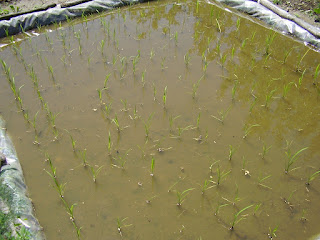When I got the idea of planting rice in an area that had only seen rice in groceries stores I must admit that I wasn`t sure how it will all turn up. Well, it turned up just fine and left me with question why people stick to growing cultures that they have been growing for decades especially now when you can get the seed very easily. It is much more practical to walk into the store and buy bag of rice but it is by far greater pleasure seeing something you saw grow and develop into strong plant and bare fruit. You will see that growing rice is not problem at all and it is very fun! OK, you have to put some muscle in it at the beginning but later comes the fun part. I have taken general description of rice from Wikipedia since there is no point in writing my own when there is already one well written.
| About rice taken from Wikipedia...(link)
Rice is the seed of the monocot plants Oryza sativa (Asian rice) or Oryza glaberrima (African rice). As a cereal grain, it is the most important staple food for a large part of the world's human population, especially in Asia and the West Indies. It is the grain with the second-highest worldwide production, after maize (corn), according to data for 2010.
Since a large portion of maize crops are grown for purposes other than human consumption, rice is the most important grain with regard to human nutrition and caloric intake, providing more than one fifth of the calories consumed worldwide by the human species.
There are many varieties of rice and culinary preferences tend to vary regionally. For example in India, there is a saying that "grains of rice should be like two brothers", close but not stuck together, while in the Far East there is a preference for softer, stickier varieties. Because of its importance as a staple food, rice has considerable cultural importance. For example, rice is first mentioned in the Yajur Veda and then is frequently referred to in Sanskrit texts.[citation needed] Rice is often directly associated with prosperity and fertility, therefore there is the custom of throwing rice at weddings.
Rice is normally grown as an annual plant, although in tropical areas it can survive as a perennial and can produce a ratoon crop for up to 30 years.[4] The rice plant can grow to 1–1.8 m (3.3–5.9 ft) tall, occasionally more depending on the variety and soil fertility. It has long, slender leaves 50–100 cm (20–39 in) long and 2–2.5 cm (0.79–0.98 in) broad. The small wind-pollinated flowers are produced in a branched arching to pendulous inflorescence 30–50 cm (12–20 in) long. The edible seed is a grain (caryopsis) 5–12 mm (0.20–0.47 in) long and 2–3 mm (0.079–0.12 in) thick.
Rice cultivation is well-suited to countries and regions with low labor costs and high rainfall, as it is labor-intensive to cultivate and requires ample water. Rice can be grown practically anywhere, even on a steep hill or mountain. Although its parent species are native to Asia and certain parts of Africa, centuries of trade and exportation have made it commonplace in many cultures worldwide.
The traditional method for cultivating rice is flooding the fields while, or after, setting the young seedlings. This simple method requires sound planning and servicing of the water damming and channeling, but reduces the growth of less robust weed and pest plants that have no submerged growth state, and deters vermin. While flooding is not mandatory for the cultivation of rice, all other methods of irrigation require higher effort in weed and pest control during growth periods and a different approach for fertilizing the soil.
|
Now my story...
Germinating rice is not a problem. Simply put them into the water and if the seed is viable they will germinate either in 24 hours or 48 hours. Since it was still cold outside at the time I put the seed to germinate I placed the box with the seed inside. At the bottom of the box was 2.5 cm of soil (1 in) and a little water (just enough to cover the seed). After they germinated and developed first 2-3 leafs i began to planning place where rice will grow for the next few months.
I had to steal some land from my mothers garden but as soon as I did that I faced a big problem; rice grows in water most of the time and the soil we have will not retain water. So, creativity had to kick in...after measuring the surface where rice will be planted (9m² or 96ft²) I went to the store and bought the cheapest nylon foil.The rice parcel needs to last only one year so there is no need to buy the expensive one.
|
|
Total depth to which I dug was around 35 cm (13.8 in) giving the soil 20 cm (7.9 in) and water 15 cm (5.9 in). It was a bit of a problem to dig a hole and then return soil back after nylon foil was laid so I did it section by section. I would lift 40 cm (15.7 in) of soil in front of me, clear the bottom, lay the nylon foil and then throw next section of 40 cm on the nylon.
|
|
|
|
Few days later, when soil under water settled down it was time to plant rice seedlings. Distance between plants in all directions was 15 cm (5.9 in). Later on I realized that it is not enough because plants grow big and everything gets crowded. At the time I was planting them it was windy so some plants drowned, especially those that were planted more to the center of the parcel. I couldn`t reach them to straighten them up :(. Also, few days after planting the seedlings green algae developed on the water surface but they gradually dissipated. They somewhat helped young seedlings keep stability while wind was blowing since root was still weak.
And this is all there is to it. It is important that soil is always moist. Water can and will evaporate in the sun but as long as the soil is moist plants will be fine. I have read that there are some species that can grow without water for some time. I tried to keep about 5 cm (2 in) of water at all time but during the rainy periods that level went up and sometimes water disappear completely :).
Here is how it grew...
90% of my rice plants started to produce flower during the drought period which resulted in 50% decreased production of grain clusters. Row with older plants flowered one month earlier and these plants produced up to 40 grain clusters per plant.
|
|
Decreased number of grain clusters is obvious. During the drought period rice parcel got much less water than it was needed and that is the main reason for decreased number of grain clusters. Parcel is approximately 9 m2 (96 ft2) and average amount of water received during the August was 50 liters/day (13.2 gallons/day). Situation in general was very delicate because there was no rain for a long period so most important thing was to keep plants alive. 50 liters/day did a good job. Yield was smaller but good.
24.09.2012.
Second half of September brought rain and soon after the first rain rice was ready for harvesting. I separated rice seed from the straw by hands wearing constructing gloves. Rice is very sharp and by the time I was done it made hole on the gloves :(. So, that is one part where you have to be careful working with handling rice.
|
| |
|
|
|
|
|
|
|
|
|
02.10.2012.
A week later I did a germination test. Result:
- germination rate 100%
- germination time 2 days
|
|
|



.jpg)
.jpg)
.jpg)





























.jpg)













0 comments:
Post a Comment